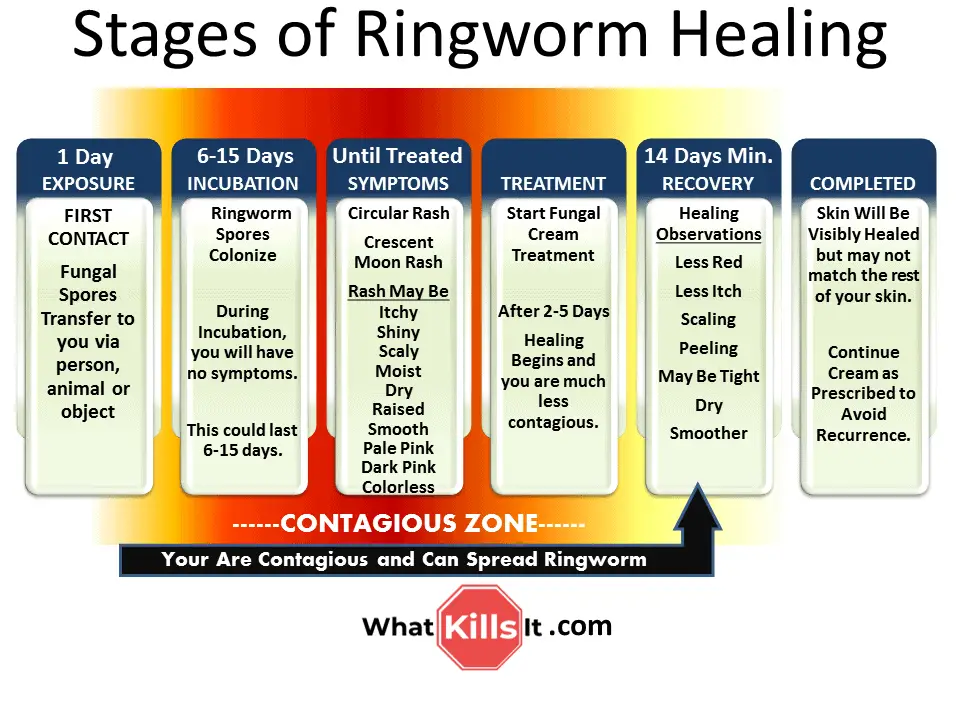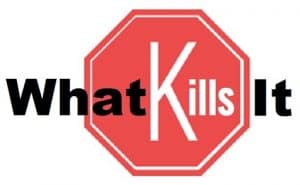posts and pages could include affiliate links which may result in earnings for the site. As an amazon associate, we earn from qualified purchases.
Okay. So you think you have ringworm. A physician gave you a fungal exposure test and your results will be available by the end of the day. After the disappointing news you were given a prescription for anti-fungal cream or you’re told to get yourself some over the counter Lotrimin before being sent on your way.
Whether you head to your local pharmacy, or leave it to amazon to deliver Lotrimin antifungal ringworm cream for yourself, or Curab Shampoo for the pets: you’ve got this!
After several days of treatment, you’re happy to report less itching, and even the redness is reduced. You feel normal again, but are you cured? Did the ringworm resolve?
In a word: No. The stages of ringworm healing has only just begun! As you’re about to see in the upcoming ringworm healing chart, a typical ringworm infection, even with treatment takes 2-4 weeks to be fully eradicated.
What’s more is as long as you have ringworm, you can infect someone else and they, in turn, can re-infect you.
Pets and People and Ringworm
Please also note: if you have pets, your home is even more susceptible to the never ending cycle of ringworm and the passing of ringworm back and forth until the fungus is removed from your home.
If this sounds familiar, read our in-house article: cleaners that kill ringworm.
Let’s cover the stages of healing so you can get an idea of where you might be in the process and then we’ll cover some other FAQ’s about ringworm.
Stages of Ringworm Healing Chart
Here is a visual chart of the progression of ringworm. It sequences a ringworm infection from first exposure to the time you’re completely healed. The color zone means you are contagious and can pass ringworm spores to someone else (or your pet).

How long does ringworm take to appear?
The typical symptoms of a ringworm fungal infection are: redness, irritation, itching, cracked or scaly skin, bumps and/or ring-shaped rashes.
These symptoms appear within one or two weeks following contact with the infecting source. Most often it will appear on one of these areas of the body: the toes and feet (tinea pedis; “athlete’s foot”), underarms or torso (tinea corpus),and the genitals or buttocks (tinea cruris; “jock itch”).
Note: if your ringworm is on the toes and feet, (athlete’s foot) consider Lotrimin spray (link to spray product) vs. cream, especially if it’s hard for you to reach your feet. The spray is known for getting into hard to reach places.
It may also occur on the scalp when hair is regularly sweat-laden and hot, such as under a hard hat. This last type of infection should be treated immediately by a doctor as it can be more severe.
How long does ringworm take to heal?
While the actual length of time will differ from person to person, it generally takes 2-4 weeks for the condition to clear up with treatment. Here are some ways to tell where you are in the healing process:
Stages of Ringworm Healing – With Treatment
Stage 1: Less itching
The first symptoms of ringworm that will diminish during treatment are the itching and redness. Blisters and the ring-shaped rash will still be present, but may look less red and irritated. It is important that you continue using the anti-fungal even though you may be “feeling better.”
Stage 2: Flaky skin appearing
The next sign the ringworm infection is healing is the appearance of flaky skin. Do not use hand or body lotions unless instructed by your physician. Wash the skin with warm water and pat dry with a soft cloth. Continue applying your anti-fungal ointment as prescribed.
Stage 3: Skin sores oozing
Oozing sores are the body’s way of flushing infection. Do not prematurely puncture or drain blisters. Wash only with warm water and pat dry with a soft cloth. Continue applying your anti-fungal ointment as prescribed.
Stage 4: Redness fading
Skin will appear mostly normal with minor blemishes. During this stage your prescription will may run out. Still wash area with care and watch for any breaks in the skin or return of symptoms. Consult your Dr. at once if you’re re-entering the cycle.
How to tell if skin fungus is dying
Two to four weeks is a long time for a ringworm infection to heal. How can you be sure the otc ointment or prescribed fungal cream is doing its job? When you are applying the anti-fungal ointment every day, you may wonder about some things you see at the infection site:
Why does ringworm cause flaking skin?
Dry or flaky skin is a sign that the fungus is being deprived of the damp, musty conditions it needed to grow. This is good! Wash with warm water and pat dry with a soft cloth. Do not rub, or scarring may occur.
Does ringworm ooze when healing?
Yes. Even if you’re avoiding scratching or rubbing, some parts of the infected area may ooze or drip. This draining is necessary for the healing to progress properly. Wash carefully with warm water and a soft cloth. Alcohols or antiseptics can damage the healing skin so follow Dr’s orders only.
The oozing condition will diminish over time as the infecting fungus is killed off and healthy skin replaces it.
Back to the doctor?
The healing process does take time and goes through several stages. Most doctors and pharmacists will tell you to KEEP using the cream even though you think the ringworm is gone. Visit your doctor if:
- the infection appears to spread
- the healing seems “stuck” in one stage
- the rash returns: redness, irritation, itching, cracked or scaly skin, bumps and/or ring-shaped rashes.
Preventing future infections
How can you avoid a ringworm infection in the future? Remember, the fungus that causes ringworm thrives in damp, dark places. Pay particular attention to body areas with joints and creases where sweat and dirt can easily collect.
Here are a few preventative measures:
- Avoid areas where fungal infections are common
- Wear protective gloves while treating another infected person or animal.
- Wear clean breathable fabrics, like cotton, around feet and genitals.
- Dry skin thoroughly before dressing.
- Wash sweat and grime from skin and hair as soon as possible following vigorous activity.
Background: What is ringworm?
Despite the name, ringworm is not a worm infection. Ringworm infections are a type of dermatophyte (skin infection) and cannot be treated with a de-wormer. Ringworm is caused by contact with fungus. Fungus thrives in dark, damp areas and can infect people or animals. Ringworm can infect almost any part of the body if the climate is hot and humid.
Ringworm can be transmitted animal to human, and human to human as long as the lesions or ring-shaped marks are visible, oozing, or otherwise opened.
Ringworm Healing Summary
Some ringworm infections can be severe and require systemic treatment by a doctor (such as the scalp variety). However, most are successfully treated by applying an anti-fungal ointment to the infection site. The ointment can be prescribed by a doctor or purchased over the counter. The active ingredient in most anti-fungal ointments for humans is clotrimazole.
The ointment is typically applied for two weeks, but it can take up to four weeks to resolve some severe infections. Follow your doctor’s instructions.
–
Resources:
Centers for Disease Control, “Ringworm” https://www.cdc.gov/fungal/diseases/ringworm/treatment.html
The Mayo Clinic, “Ringworm” https://www.mayoclinic.org/diseases-conditions/ringworm-body/symptoms-causes/syc-20353780
World Health Organization, “Dermatophyte infections” https://apps.who.int/medicinedocs/en/d/Jh2918e/5.html
Stoppler, Melissa C., Dr. “Ringworm” MedicineNet https://www.medicinenet.com/ringworm/article.htm
